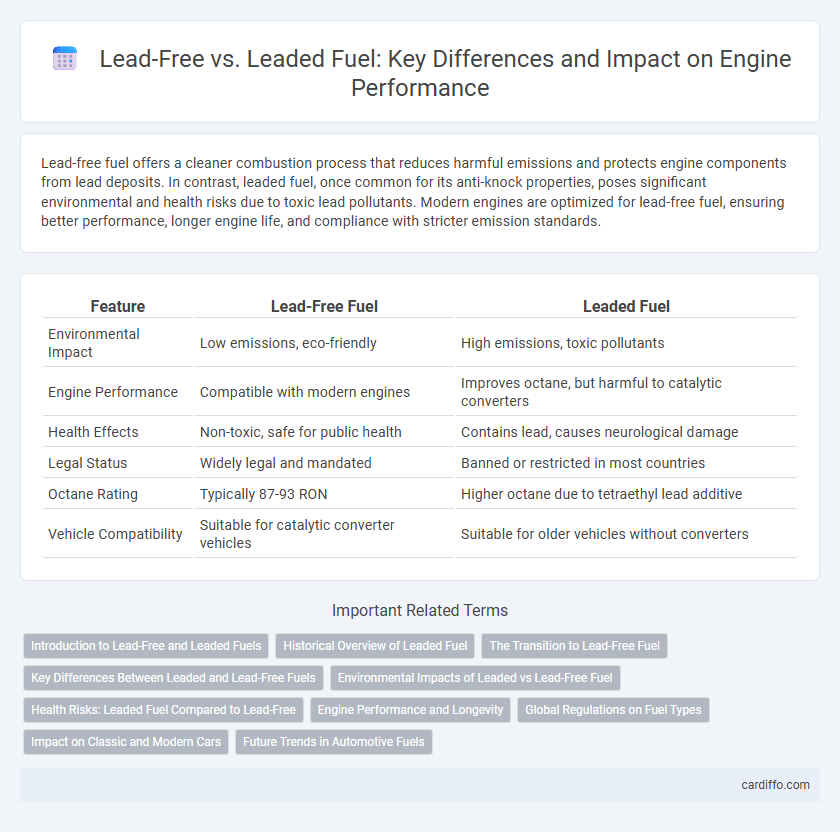Lead-free fuel offers a cleaner combustion process that reduces harmful emissions and protects engine components from lead deposits. In contrast, leaded fuel, once common for its anti-knock properties, poses significant environmental and health risks due to toxic lead pollutants. Modern engines are optimized for lead-free fuel, ensuring better performance, longer engine life, and compliance with stricter emission standards.
Table of Comparison
| Feature | Lead-Free Fuel | Leaded Fuel |
|---|---|---|
| Environmental Impact | Low emissions, eco-friendly | High emissions, toxic pollutants |
| Engine Performance | Compatible with modern engines | Improves octane, but harmful to catalytic converters |
| Health Effects | Non-toxic, safe for public health | Contains lead, causes neurological damage |
| Legal Status | Widely legal and mandated | Banned or restricted in most countries |
| Octane Rating | Typically 87-93 RON | Higher octane due to tetraethyl lead additive |
| Vehicle Compatibility | Suitable for catalytic converter vehicles | Suitable for older vehicles without converters |
Introduction to Lead-Free and Leaded Fuels
Lead-free fuel, commonly known as unleaded gasoline, contains no tetraethyl lead additives, reducing harmful emissions that contribute to air pollution and health issues. Leaded fuel, historically used to enhance engine performance and prevent knocking, contains tetraethyl lead which poses significant environmental and health risks due to toxic lead exposure. The transition to lead-free fuel has been driven by regulations aimed at minimizing lead pollution and protecting public health worldwide.
Historical Overview of Leaded Fuel
Leaded fuel was introduced in the 1920s to improve engine performance by reducing knocking and enhancing combustion efficiency, becoming a standard additive in gasoline for several decades. Its widespread use led to significant environmental and public health issues due to lead emissions, causing neurological damage and pollution. Regulatory actions in the 1970s and beyond gradually phased out leaded fuel, replacing it with unleaded alternatives to minimize these adverse effects.
The Transition to Lead-Free Fuel
The transition to lead-free fuel has significantly reduced environmental pollution and improved public health by eliminating tetraethyl lead, a toxic additive previously used to enhance octane levels. Lead-free gasoline now meets stringent regulations set by environmental agencies worldwide, promoting cleaner air and reducing engine wear through advanced additive technologies. Automakers and fuel producers have collaborated to phase out leaded fuel, ensuring compatibility with modern emission control systems and enhancing long-term vehicle performance.
Key Differences Between Leaded and Lead-Free Fuels
Lead-free fuel, also known as unleaded gasoline, contains no tetraethyl lead additives, reducing harmful emissions and environmental pollution compared to leaded fuel. Leaded fuel includes tetraethyl lead to increase octane rating and prevent engine knocking but contributes to lead poisoning and environmental toxicity. Modern engines are designed to run solely on lead-free fuel, promoting better air quality and engine efficiency.
Environmental Impacts of Leaded vs Lead-Free Fuel
Lead-free fuel significantly reduces toxic emissions compared to leaded fuel, preventing harmful lead particles from contaminating air, soil, and water. The elimination of lead additives in fuel lowers the risk of neurological damage in humans and wildlife caused by lead exposure. Transitioning to lead-free fuel supports cleaner air quality and aligns with global environmental regulations targeting pollution reduction.
Health Risks: Leaded Fuel Compared to Lead-Free
Leaded fuel releases toxic lead particles into the air, posing significant health risks such as neurological damage, developmental delays in children, and increased cardiovascular problems in adults. Exposure to lead from leaded gasoline can result in impaired cognitive function and elevated blood lead levels, leading to chronic health issues and increased mortality rates. Switching to lead-free fuel eliminates these risks by reducing airborne lead emissions and improving overall air quality.
Engine Performance and Longevity
Lead-free fuel enhances engine performance by reducing deposit formation and preventing spark plug fouling, resulting in smoother combustion and improved fuel efficiency. In contrast, leaded fuel can cause valve seat wear and increased engine deposits, which degrade performance over time. Modern engines designed for unleaded fuel benefit from increased longevity and lower maintenance costs compared to those using leaded gasoline.
Global Regulations on Fuel Types
Global regulations increasingly mandate the use of lead-free fuel to reduce environmental pollution and health risks associated with leaded gasoline. Many countries have phased out leaded fuel entirely, aligning with standards set by organizations such as the World Health Organization and the United Nations Environment Programme. Compliance with Euro 6 emissions standards and similar regulations worldwide drives the transition toward unleaded fuels to ensure cleaner air quality and vehicle compatibility.
Impact on Classic and Modern Cars
Lead-free fuel significantly reduces engine deposits and wear in both classic and modern cars, promoting longer engine life and improved performance. Classic cars designed for leaded fuel may require additives or modifications to prevent valve seat recession when using unleaded fuel. Modern engines rely on lead-free fuel to comply with emissions regulations and maintain catalytic converter efficiency, ensuring cleaner exhaust emissions.
Future Trends in Automotive Fuels
The automotive industry is rapidly shifting towards lead-free fuels due to stringent environmental regulations and the global push for cleaner air quality. Innovations in alternative fuel technologies, such as electric vehicles and hydrogen-powered engines, emphasize the decline of leaded gasoline in future transportation solutions. Market forecasts predict a near-complete phase-out of leaded fuel by 2030, aligning with sustainability goals and advancements in emission reduction standards.
Lead-Free vs Leaded Fuel Infographic

 cardiffo.com
cardiffo.com